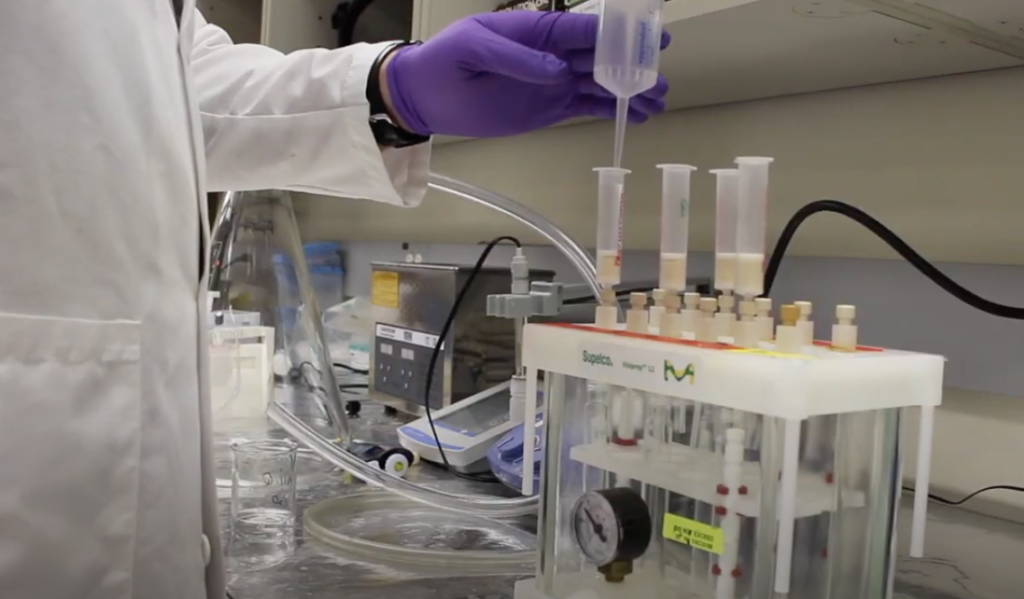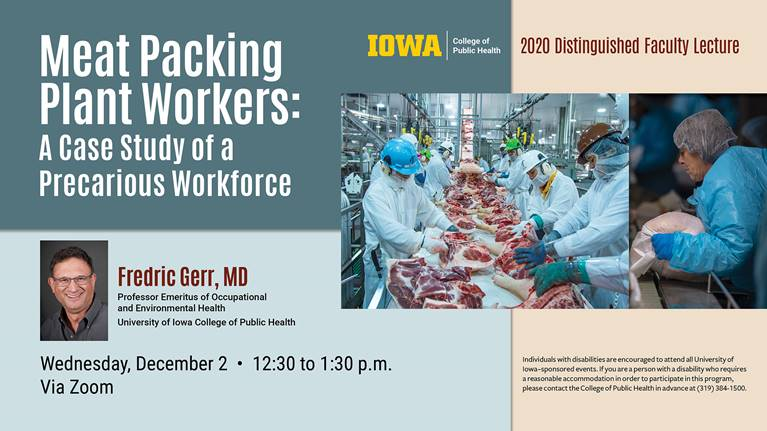Lab tour video – Lehmler Lab
Phd Candidate Derek Simonsen explains the work that goes on in Dr. Hans Lehmler’s lab and the Exposure Science Facility. Watch it now!

2020 Distinguished Faculty Lecture coming Dec 2
The College of Public Health’s Distinguished Faculty Lecture will take place on December 2, 2020, from 12:30-1:30 P.M. This year’s lecture will be given by EHSRC member, Dr. Fred Gerr, and will provide an overview of historical and current occupational injury and illnesses among meat packing plant workers.
Dr. Gerr has served as a professor in the Department of Occupational and Environmental Health for the last 18 years. He has been the director of both the Great Plains Center for Agricultural Health and the Occupational Medicine Residency Training Program in CPH for many years. He has taught Occupational Health Practice, Occupational Medicine, and Interpreting Occupational Health Research. His research focuses on occupational and environmental risk factors for neurological impairment and musculoskeletal disorders. He has made significant contributions in the specialty of occupational and environmental medicine.
2020 CPH Distinguished Faculty Lecture | December 2 at 12:30 P.M.
Join via Zoom (https://uiowa.zoom.us/j/93121351181)

New framework helps researchers return results to participants
Dr. Brandi Janssen, Director of the EHSRC Community Engagement Core, collaborated with colleagues at Emory, University of North Carolina, and University of New Mexico to publish a paper about reporting back to communities. It was featured as a paper of the month on the NIEHS Environmental Factor newsletter. See write up below:
NIEHS grantees developed a framework and set of recommendations to help environmental health researchers return research results to study participants, a process called result report-back. According to the authors, report-back has the potential to improve environmental health education and communication and overall public health. Despite strong recommendations for report-back, researchers share results with study participants infrequently and inconsistently, the authors said.
To create the framework, the researchers used feedback from 35 community engagement practitioners who participated in a workshop at the 2018 NIEHS Partnerships for Environmental Public Health Annual Meeting. Workshop attendees responded to the prompt: “What are some specific issues that are relevant to reporting back research results to individuals or the larger community?” Participants then grouped similar responses and rated groups by importance to successful result report-back. The researchers used qualitative and quantitative methods to create a framework, called a concept map, to visualize relationships between responses.
Five themes emerged from this process. Listed from most to least important, the themes were: effective communication strategies, community knowledge and concerns, uncertainty, empowering action, and institutional review and oversight. Engaging community partners in the process of result report-back emerged as a unifying global theme. The researchers further examined responses and made recommendations to address challenges within and across themes.
Environmental health researchers and practitioners should address these five specific themes when planning and implementing their result report-back activities, say the authors.
Citation: Lebow-Skelley E, Yelton S, Janssen B, Erdei E, Pearson MA. 2020. Identifying issues and priorities in reporting back environmental health data. Int J Environ Res Public Health 17(18):6742.
Fall 2020 Seminar Schedule
The Human Toxicology and EHSRC Research Seminar line-up has been announced. Seminars are every Friday at 10:45 am and will be via zoom. Check out the page for more details
- « Previous Page
- 1
- …
- 8
- 9
- 10
- 11
- 12
- …
- 14
- Next Page »